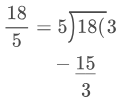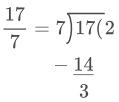Session 2: Types of Fractions – Definition, Interactives and Examples
Fractions are one of the most essential and exciting concepts of Mathematics. The study of fractions helps us understand daily interactions with one another better. Dividing things- be they a cup of sugar or a pizza-using fractions is a great way to demonstrate fairness.
In this lesson, we shall learn about unit fractions, proper and improper fractions, mixed fractions, like and unlike fractions and equivalent fractions.
Types of Fractions
A fraction is a part of a whole. It describes the relationship between a part of something and the whole thing. A fraction has two numbers separated by a fraction bar. The top number is called the numerator and tells you how many parts there are out of the whole. The bottom number is the denominator. It tells you how many parts the whole has been divided into.
Based on numerator and denominator, a fraction can be classified under the following categories:
Proper Fractions:
When fractions have a numerator smaller than the denominator, they are called proper fractions. \(\frac{1}{2}\), \(\frac{8}{11}\) and \(\frac{5}{6}\) are examples of proper fractions.
Improper Fractions:
When fractions have a numerator greater than the denominator, they are called improper fractions. \(\frac{6}{5}\), \(\frac{8}{3}\) and \(\frac{12}{7}\) are examples of improper fractions.
Mixed Numbers or Mixed Fractions:
A combination of a whole number and a proper fraction is called a mixed fraction. \(3\frac{2}{5}\), \(4\frac{1}{2}\) and \(6\frac{1}{3}\) are examples of mixed fractions.
Unit Fractions:
When fractions have 1 as the numerator, they are called unit fractions. \(\frac{1}{11}\), \(\frac{1}{5}\), \(\frac{1}{4}\), \(\frac{1}{2}\) and \(\frac{1}{8}\) are examples of unit fractions.
Improper and Mixed Fractions
When we compute with fractions, we must be able to express mixed fractions as improper fractions and vice versa.
Convert Mixed Fraction into an Improper Fraction
1) Convert 323 into an improper fraction.
- Multiply the whole number part by the denominator (3×3=9).
- Add the product to the numerator (9+2=11).
- Write the sum over the denominator \(\frac{11}{3}\).
\(3\frac{2}{3}\)=\(\frac{(3\times 3)+2}{2}\)=\(\frac{11}{3}\) (Improper Fraction)
Convert Improper Fraction into a Mixed Fraction
2) Convert \(\frac{25}{8}\) into a mixed fraction.
- Divide the numerator by the denominator. Write the quotient as the whole number part (25÷8=3R1)
- If there is a remainder, write it over the denominator and express the fraction in the simplest form. \(3\frac{1}{8}\).

\(\frac{25}{8}\)=\(3\frac{1}{8}\) [ Mixed Fraction ]
A group of fractions can also be classified under the following categories:
Like Fractions:
When fractions have the same denominator, they are called like fractions.\(\frac{11}{3}\), \(\frac{7}{3}\), \(\frac{5}{3}\), \(\frac{2}{3}\) and \(\frac{1}{3}\) are examples of like fractions.
Unlike Fractions:
When fractions have different denominators, they are called unlike fractions. \(\frac{2}{3}\), \(\frac{4}{5}\), \(\frac{5}{4}\), \(\frac{1}{2}\) and \(\frac{3}{8}\) are examples of unlike fractions.
Equivalent Fractions
What do we mean by equivalent? When two or more things are the same, they are called equivalent. Look at these two diagrams.
The first one shows \(\frac{1}{2}\) shaded, and the second one shows \(\frac{2}{4}\) shaded.
Is there any difference between the sizes of the parts? Yes. The first fractional bar shows bigger parts, and the second shows smaller parts. Is there any difference in the size of the shaded parts? No.
In the first fractional bar, 1 out of 2 is shaded. In the second, 2 out of 4 are shaded. So, the same quantity is shaded in both, but they are called differently, i.e., \(\frac{1}{2}\) and \(\frac{2}{4}\). These two fractions are called equivalent fractions.
Carefully observe the fraction board below. It represents equivalent fractions. Remember the two fractions must be of equal value, even if they are divided into different sizes.
Here, \(\frac{1}{2}\)=\(\frac{2}{4}\)=\(\frac{3}{6}\)=\(\frac{4}{8}\)=\(\frac{5}{10}\) are all equivalent fractions.
To find equivalent fractions, multiply or divide the numerator and denominator of the fraction by the same non-zero number. This does not change the value because it is the same as multiplying or dividing by 1.
3) Find the missing numerator in the following equivalent fractions.
\(\frac{3}{4}\)=\(\frac{n}{16}\)
To get 16 in the denominator, we multiply 4 by 4 (∵4×4=16)and 3 by 4.

\(\frac{3}{4}\) and \(\frac{12}{16}\) are equivalent fractions.
Note: If ![]() and
and ![]() are equivalent fractions, then
are equivalent fractions, then ![]()
Reducing Fractions to their Lowest Terms
A fraction is in simplest form, or lowest terms, when the numerator and denominator have no common factor other than 1.
4) Reduce \(\frac{16}{48}\) to its simplest form.
We know that 4 is a common factor of 16 and 48. So let us divide both 16 and 48 by 4.
16÷4=4
48÷4=12
So, \(\frac{4}{12}\) is an equivalent fraction of \(\frac{16}{48}\) with lower terms. But we are asked to find the equivalent fraction with the lowest term.
\(\frac{4}{12}\) is not a fraction with the lowest term; 4 and 12 have a common factor, 4. So we need to again reduce \(\frac{4}{12}\) to a lower term by dividing by the common factor, 4, and we get \(\frac{1}{3}\).
To avoid this long process, we can divide by the highest common factor(H.C.F) the first time itself. Here, 16 is the highest common factor of 16 and 48. So, 16÷16=1 and 48÷16=3.
So, \(\frac{16}{48}\)=\(\frac{1}{3}\).
Types of Fractions – Examples
Example 1
Express the following improper fractions as mixed fractions
i. 18/5
ii. 17/7
i. We have,

∴ Quotient = 3, Remainder = 3, Denominator = 5
Hence, \(\frac{18}{5}\)=\(3\frac{3}{5}\) (Mixed fraction)
ii. We have

∴ Quotient = 2, Remainder = 3, Denominator = 7
Hence, \(\frac{17}{7}\)=\(2\frac{3}{7}\) (Mixed fraction)
Example 2
Express the following mixed fractions as improper fractions.
i.\(2\frac{1}{6}\)
ii. \(5\frac{2}{11}\)
i. We have

ii. We have

Example 3
Write five equivalent fractions of \(\frac{4}{5}\).
Equivalent fractions of \(\frac{4}{5}\) are:

Example 4
Find the missing denominator in the following equivalent fractions.

To get 5 in the numerator, we divide 40 by 8 (∵40÷8=5) and 48 by 8.

\(\frac{5}{6}\) and \(\frac{40}{48}\) are equivalent fractions.
Example 5
Check whether the following pairs of fractions are equivalent or not.
i. \(\frac{6}{11}\), \(\frac{24}{44}\)
ii. \(\frac{4}{9}\), \(\frac{36}{72}\)
We can check whether two fractions are equivalent or not by cross multiplication. If the two products are equal, then the given fractions are equivalent, otherwise not.
i. By cross-multiplication, we have
6×44=264 and 11×24=264
Since the two products are equal, the given fractions are equivalent.
ii. By cross-multiplication, we have
4×72=288 and 9×36=324
Since the two products are not equal, the given fractions are not equivalent.
Remember this!
- A fraction is a number representing a part of a whole.
- A fraction can be expressed in the form of \(\frac{a}{b}\), where a, b are whole numbers and b≠0.
- A fraction whose numerator is less than the denominator is called a proper fraction.
- A fraction whose numerator is more than or equal to the denominator is called an improper fraction.
- A combination of a whole number and a proper fraction is called a mixed fraction.
- To get a fraction equivalent to a given fraction, we multiply (or divide) its numerator and denominator by the same non-zero number.
- Fractions having the same denominators are called like fractions. Otherwise, they are called unlike fractions.
- A fraction is in its lowest terms if its numerator and denominator have no common factor other than 1.








